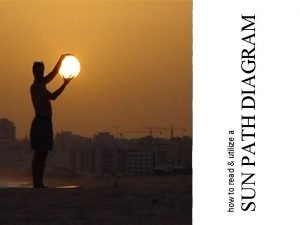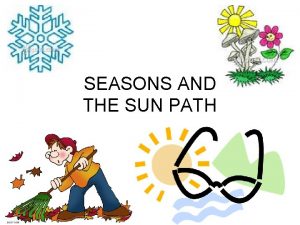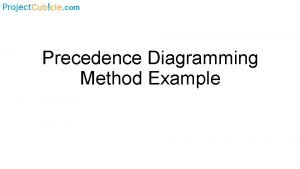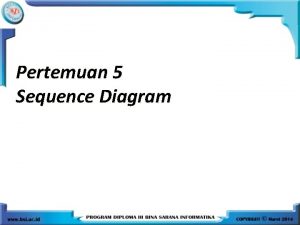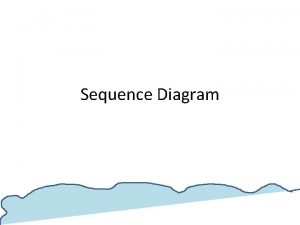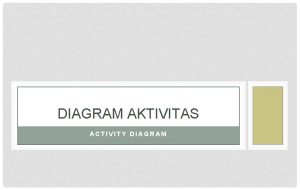SUN PATH DIAGRAM how to read utilize a









- Slides: 9

SUN PATH DIAGRAM how to read & utilize a

Sun Path: Sun Positions http: //wiki. naturalfrequency. com/wiki/Sun-Path/Reading_Sun_Positions GOOD READ begin with a Solar Position Tutorial by Autodesk http: //sustainabilityworkshop. autodesk. com/buildings/solar-position

• • • Each location has a unique sun path diagram. Find the diagram for your site using its latitude and longitude coordinates. You can use an existing sun path diagram (for a larger city) or create your own using a sun path diagram generator. The sun is the highest at the summer solstice (June 21) and the lowest at the winter solstice (December 21) The sun is in between the solstices at the spring/fall equinoxes (March 20/September 22) In the northern hemisphere, direct sunlight comes from the east, west, and south, but not the north. In the southern hemisphere, direct sunlight comes from the east, west, and north, but not the south. KEEP IN MIND some things to •

• • Position your building in the center of the diagram facing the direction it actually faces on the site. When creating a section diagram, it is best to cut the building along its North/South axis. At a minimum, show the noon sun at the solstices, its lowest and highest points in the sky (June 21/December 21). This will show the extreme solar conditions for the site. KEEP IN MIND some things to •

Showing a view facing the southern side of the building may have afforded a better understanding of the glazing that would be affected by the sun. In addition, the word, “equinox” should be added to the spring & fall label. It may be appropriate to label the location of the building (city, state, country, etc. ) as well. This type of diagram is most useful when used with section diagrams (see following slides). EXAMPLES diagram This diagram demonstrates the position of the sun on three different times of year, the winter solstice (December 21), the summer solstice (June 21), and the spring/fall equinoxes (March 20/September 22). Building orientation is clearly defined, building shadows are projected, and the graphics are very simple, engaging, and informative.

What is missing/unclear about this diagram is the time of day/year we are looking at. The sun would produce different results depending on the time of day and whether or not it is summer/winter solstice or the spring/fall equinox. Separate diagrams may be necessary to document the effect of the sun during other times of the day/year. It would also be useful to know what interior spaces we are looking at. Labels would certainly be useful to better understand this diagram. EXAMPLES diagram This diagram demonstrates the effect of a light shelf in an interior space. It shows us that most of the light would bounce off the light shelf and in turn the ceiling, bringing reflected daylight deeper into the interior. The graphics are engaging, and the use of human figures is effective.

What is missing/unclear about this diagram is the time of day we are looking at. The sun would produce different results depending on the time of day. Separate diagrams or graphic modifications may be necessary to document the effect of the sun during other times of the day. It would also be useful to know what interior spaces we are looking at. Labels indicating the time of day and names of rooms/interior spaces would certainly be useful to better understand this diagram. EXAMPLES diagram This diagram demonstrates the amount of sun that would penetrate an interior space on two different times of year, the winter solstice (December 21) and a date between the winter and summer solstice (April 21). It includes the altitude of the sun in degrees. The graphics are very simple, engaging, and informative.

What is missing/unclear about this diagram is what happens to the taller structure during the summer solstice. If nearby vegetation (e. g. , trees) contributes to the amount of daylight penetrating the space, they should be included and noted. Shadows cast by the building may be relevant to show if they include exterior rooms/spaces, or other spaces to be occupied by users. It would also be useful to know what interior spaces we are looking at. Labels indicating the names of rooms/interior spaces would certainly be useful to better understand this diagram. EXAMPLES diagram This diagram demonstrates the amount of sun that would penetrate an interior space on two different times of year, the winter solstice (December 21) and the summer solstice (June 21). The graphics are very simple, engaging, and informative.

EXAMPLES diagram Of course, there are other ways to demonstrate how the sun’s path will affect your interior space. Feel free to experiment with graphic representation, and consider showing both an overall building diagram as well as a section diagram. Just be sure the critical information is in place: • Overall label for the diagram • Time of Year (2 minimum, 1 at each solstice) • Time of Day (show noon at a minimum) • Location (may include: city, state, country, latitude, longitude, time zone, etc. ) • Labels for all components, including names of interior spaces (for sections) • Nearby vegetation and shadows cast by the building itself (may be included if it affects shading of interior/occupied spaces)
